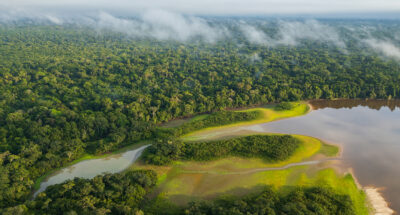
Staying committed on net-zero goals is true test of leadership
Companies have buckled under pressure from the Trump administration and challenging economic conditions, but now's not the time to abandon sustainability goals....
Audio available

by Maryanne Ochola Published January 8, 2024 in Purpose • 6 min read •

Better connected
M-PESA, the mobile money service, has transformed the lives of millions of Africans.
M-PESA, the mobile money service, hosts transactions worth more than 50% of Kenya’s GDP and serves more than 50 million customers in seven African countries. This runaway success story, credited with lifting 2% of Kenyan households out of poverty, was catalyzed by a £1m UK government grant 15 years ago. It’s just one example of the power of impact investing to transform economies across Africa.
Early on, the UK grant de-risked M-PESA enabling follow-on commercial capital to come in and support its growth, helping to create a financial inclusion ecosystem that now fuels scalable innovation in Kenya and beyond. Without that grant, it would have been near impossible for the company’s leadership (then the multinational Vodafone) to invest its own money in what was then a high-risk and low-return pursuit in a non-core market.
This kind of blending of impact and commercial finance has spurred innovation and opened African markets in crucial sectors such as financial services, renewable energy, and agriculture. Without it, and despite the growth of venture capital in countries such as Nigeria, Egypt, Kenya, and South Africa, entrepreneurs face challenges in accessing capital to scale their businesses. They are considered too risky by commercial banks, with considerable risk premia and collateral requirements, while public markets remain illiquid and out of reach for most.
Over the last decade, impact investing has stepped in to fill that gap. We are now seeing those initial target investments transitioning to commercial capital so that businesses can scale. Here are six ways to accelerate this movement, based on learnings from Africa’s emerging impact ecosystem (and mindful of regional nuances).
The biggest catalyst for Africa’s growth will continue to be youth job creation at scale, as the multiplier effect will be felt across the board. Therefore, all African businesses creating jobs are arguably impactful (excluding sectors causing harm). While different investors have specific mandates, a wider recognition of this reality will expand opportunities: a narrow definition of impact has constrained mostly local entrepreneurs from accessing capital and support.

To secure a more sustainable and inclusive future, we need creative ideas and partnerships that reimagine the global economy. In Issue XII of I by IMD, we explore how the fast-emerging “impact economy” is changing the way we do business – and the world.
For example, Aoko owns a restaurant chain which caters to city workers. The majority of her staff is female, and she sources traditional ingredients such as cassava leaves and edible insects from rural smallholders. A key obstacle to expanding her business is accessing a bank loan because she lacks the requisite collateral. Aoko is likely to be unaware that she can access alternative capital as an underrepresented founder (a female entrepreneur) or for supporting rural development by sourcing from smallholders.
External investors can improve their knowledge of target entrepreneurs by working more closely with local financiers. On-the-ground experts understand the context and offer support with the assessment of business models, sourcing diverse pools of entrepreneurs, and understanding growth rates or risk to identify, appraise, and manage possible funding facilities. Some development finance institutions (DFIs) have established partnerships with Kenyan banks, de-risking lending to clients (such as Aoko) by bundling capacity-building, sourcing alternative collateral, and offering proximity: her bank is just a walk away. We need more of this across Africa, especially in secondary markets and fragile states.
Just as M-PESA demonstrated with financial inclusion, we need more breakthrough innovation across other sectors such as healthcare, education, and agriculture. It is imperative that impact investing continues to take a market-building approach. Take workforce training, which is constrained by limited access to funds: The African Management Institute has leveraged philanthropic and concessional capital to build the workplace-learning market, demonstrating value to businesses and moving users from subsidized to commercial terms over time. It is important to align impact investors, entrepreneurs, and commercial capital so this kind of value-added and transition-to-scale can be achieved more widely.
There is a need to close gaps in the impact investment landscape. Most impact capital is foreign, so we need to integrate frameworks and aspirations for local capital into local policy to enable entrepreneurs to tap into a wider scope of funding. The convening power of DFIs can help to bring different actors to the table and encourage long-term policy change. The Global Steering Group for Impact Investment has catalyzed local advisory boards in markets such as Ghana, Zambia, and South Africa. The goal of similar initiatives should be to create a continuum of capital that is additive and spans the entrepreneurial journey.

“Africa will play a key role in energy transition, and we’ve seen a flurry of new climate-focused funds as DFIs – the largest source of impact finance in Africa – shift their spotlight to climate.”
The biggest win may come when perceptions of impact investing shift from “charity”, “market-distorting”, “narrowly focused”, or “foreign”. These definitions emerged as the market moved from NGO interventions in the 1980s and 90s to the VC heyday of 2020-2021. A key step requires aligning local conditions and needs with the demands of the sources of capital. Africans should sit at the decision-making table when interventions are designed and a consensus is built. For example, Africa will play a key role in energy transition, and we’ve seen a flurry of new climate-focused funds as DFIs – the largest source of impact finance in Africa – shift their spotlight to climate. It’s critical that Africa determines what interventions are prioritized, based on local context.
Equally important is building the thought-leadership, data, and research ecosystem. With a decade’s worth of activity, case studies on the de-risking of investments, capital, social and environmental impact, policy, and regulatory successes as well as exits could help cement impact investing at the heart of economic development.
A cursory glance at impact-related content reveals that there aren’t many Africans sharing their experiences. Every so often, a panel speaker cannot attend an impact conference in London or Washington, for example, due to difficulties obtaining a visa. This points to the imbalance of power in the impact economy and, without skin in the game, there’s a sense of limited local ownership. More Africans should be appointed as general partners, not just employees, of impact funds. DFIs could lead the way by building the capacity of those with local knowledge and proximity.
We can achieve both profit and impact, but the ecosystem that will support this revolution in Africa needs strengthening. Impact investors should continue to play a catalytic market-building role that unlocks opportunities and attracts commercial capital. Investors should consider broader definitions of impact, as job creation remains the most critical challenge in Africa. This will also widen the deal flow for investors.
Finally, it’s noteworthy that the ownership of M-PESA is now fully African. Impact investing, as a sector, will benefit from more Africans driving the movement, de-risking opportunities through proximity, and sharing success stories.

Maryanne Ochola is passionate about entrepreneurship and its impact on job creation in Africa. She has worked in commercial banking, impact investing, and venture capital and has a deep understanding of the evolving ecosystem. Ochola holds an MBA from IE Business School and is Managing Director of Endeavor Kenya.

November 27, 2025 • by Amanda Williams in Sustainability
Companies have buckled under pressure from the Trump administration and challenging economic conditions, but now's not the time to abandon sustainability goals....
 Audio available
Audio available
November 21, 2025 in Sustainability
Sustainability can no longer be separated from geopolitics. In this webinar, our experts discuss how rising security risks, disrupted supply chains, and circularity are redefining strategy for global leaders....

November 18, 2025 • by Sara Ratti in Sustainability
Boards can drive real climate action by linking executive pay to meaningful environmental targets, ensuring accountability beyond symbolic pledges....

November 18, 2025 • by Miljan Gutovic in Sustainability
Growing demand for building materials requires novel approaches to construction. Holcim CEO Miljan Gutovic shows how his company has adopted circularity as a new way to grow the business....
Explore first person business intelligence from top minds curated for a global executive audience